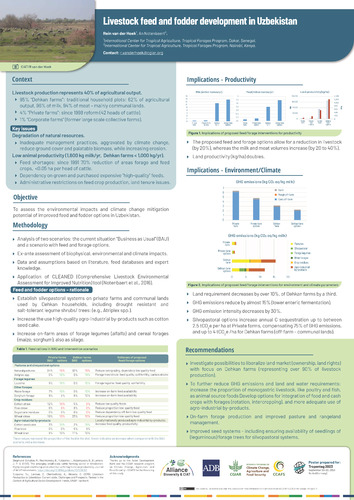Livestock feed and fodder development in Uzbekistan
In Uzbekistan, livestock production accounts for 40% of agricultural output. Since independence, areas planted with forage and feed crops have decreased by 70%, whereas the cattle population has increased by 150%, leading to a sharp increase in GHG emissions (mainly methane through enteric fermentation). Inadequate management practices, aggravated by climate change, have led to salinisation and pasture degradation.
Private farms account for over three-fourths of the total area dedicated to feed production. Small Dehkan farms account for only 13 percent of the forage area with almost 95% of the cattle herd and rely on low-quality communal pastures and (purchased) crop and agro-industrial by-products.
For both farm types the environmental impacts and climate change mitigation potential of improved feed and forages were analysed using an ex-ante assessment tool (CLEANED) for two scenarios: the current situation “Business as Usual” (BAU) and a scenario with feed and forage options including silvopastoral systems with drought resistant and salt-tolerant legume shrubs/ trees, high-quality agro-industrial by-products such as cotton seed cake and on-farm forage production (legumes and cereal crops).
Improved feed and forage options reduce environmental and climate impacts, decrease land, water and fertiliser requirements and increase biodiversity and resilience to climate change and weather shocks. GHG emissions fall by 15%, whereas productivity increases by 20% and profitability by 25%.
Within a conducive policy framework, investments should be aimed at knowledge generation, institutional strengthening and overcoming barriers for adoption of feed/forage options and scale sustainable livestock production technologies and practices. Improved farmer access to tools, training (forage production, formulation of rations), technologies, markets, veterinary care and breeding is crucial. Interventions need to be complemented with research on livestock management and productivity increase, and economically feasible options need to be further identified for improving feeding practices.

